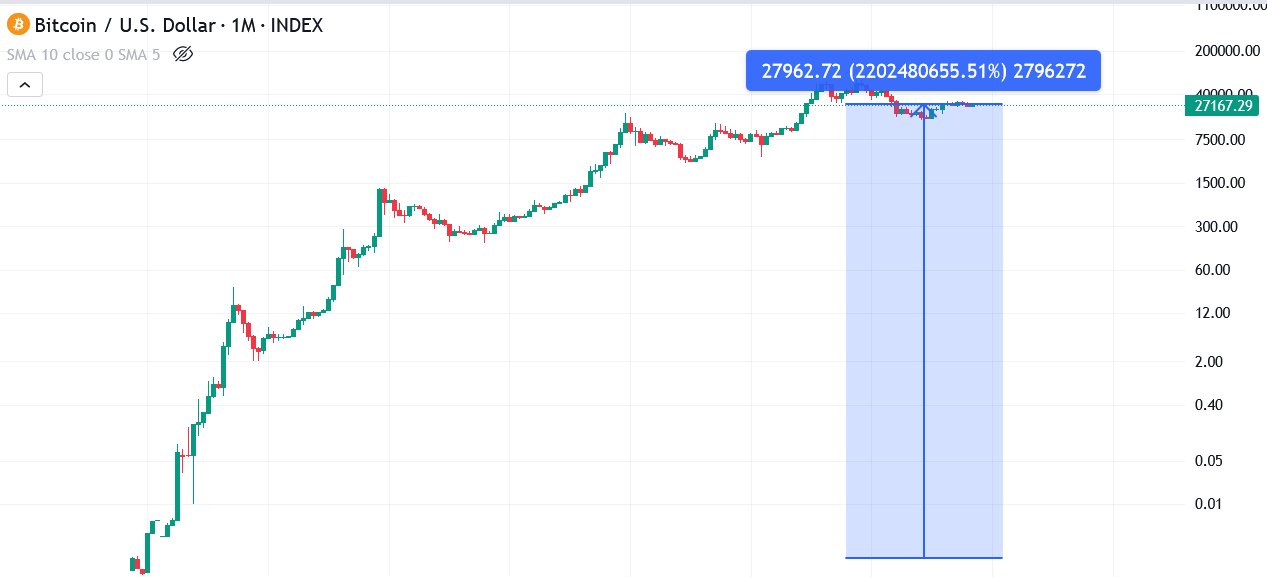Bitcoin, a digital asset, has captured the attention of people worldwide. It exists solely in the digital realm, free from government or corporate control, and is safeguarded by cryptographic technology. Upon first encountering this concept, many individuals might dismiss Bitcoin as a mere technological hoax, devoid of real-world value.
However, after fourteen years since its inception, Bitcoin remains actively traded and has transformed ordinary individuals into unexpected wealth holders, as they were among its early investors. With a current valuation of nearly $30,000 USD per Bitcoin, one Bitcoin surpasses the worth of 300 grams of gold — an astounding achievement considering its initial value of less than one cent per Bitcoin just a decade ago.

The question that looms large: Is Bitcoin a scam or an exceptional investment opportunity of a lifetime?
This article explores some of the reasons behind Bitcoin’s intrinsic value, its potential as a sound investment, the associated risks, and strategies for avoiding the common pitfalls faced by novice investors.
What is Bitcoin?
In essence, Bitcoin is a form of currency that operates within a unique global payment network. Within this network, individuals have the ability to send and receive Bitcoin while retaining control over their assets, free from concerns about account freezes or unspendable funds. This stands in stark contrast to traditional banks, where every transaction is subject to approval by intermediaries. While banks can freeze accounts, Bitcoin cannot be seized or frozen, and it can be transmitted globally without the need for a chain of intermediaries as required by banks.
One crucial aspect to understand is that Bitcoin is not issued or regulated by any government or business entity. Instead, it was initially created and introduced by an individual or group known as Satoshi Nakamoto, whose true identity and country of origin remain a mystery. Notably, Satoshi Nakamoto has remained anonymous since 2011, leaving their initial stash of Bitcoins untouched. While their identity and current status remain unknown, what is clear is that Bitcoin is not a one-person endeavor.
Today, there are numerous contributors to the Bitcoin project, with 600 actively involved and 13,000 more dedicated to maintaining the Bitcoin network, distributed across the globe. This robust and widespread community support underscores the resilience of Bitcoin, indicating that it is not a project that can be easily disbanded or abandoned.
What are the use cases for Bitcoin?
Originally, Bitcoin was conceived for peer-to-peer transactions, enabling individuals to conduct exchanges without the need for intermediaries like banks. In the early days of Bitcoin, when it was first embraced by enthusiasts, there was no established pricing mechanism to reference. Instead, Bitcoin was exchanged akin to collectible cards, with the seller and buyer agreeing upon a price. This unique characteristic contributed to the notable volatility in Bitcoin’s price.
However, as the Bitcoin market has matured, an increasing number of buyers and sellers have facilitated Bitcoin transactions at more standardized prices worldwide. Price disparities have been mitigated; for instance, if Bitcoin is priced higher in Asia than in the US, US traders can sell to the Asian markets, while Asian buyers can acquire Bitcoin at more affordable rates in North American markets. This trend has led to a more uniform global Bitcoin price.

Despite its volatility, Bitcoin has exhibited a long-term upward trajectory in price, often outpacing traditional assets. This makes Bitcoin an appealing option for long-term investment. Part of the allure may stem from the fact that Bitcoin is programmed with a supply limit of 21 million coins, while the interest in Bitcoin has surged significantly in recent years.
Many Bitcoin investors firmly believe in its potential for even greater future value. According to Crypto.com, the percentage of the global population holding Bitcoin remains under 3%, while 93% of all available Bitcoins have already been mined. This implies that there won’t be new Bitcoins to meet the potentially substantial increase in demand, further supporting the prospect of Bitcoin’s continued growth in value.
How to start investing in Bitcoin
Before diving into the world of Bitcoin investment, it’s essential to acquire a solid understanding of the cryptocurrency. While this article has provided a basic overview, there’s much more to discover. Have you explored the concept of blockchain technology, comprehended the mechanics of a Bitcoin transaction, and grasped the significance of a digital wallet? Furthermore, are you familiar with where to purchase Bitcoin?
If you find yourself uncertain about these fundamental aspects, we strongly recommend conducting further research. You can delve into these topics by exploring more in-depth articles on our website. Bitcoin’s value derives not only from its innovative technology but also from the intricate ecosystem it represents. By gaining a deeper understanding, you’ll be better equipped to appreciate the challenges Bitcoin seeks to address and why it holds long-term value.
Next, it’s advisable to broaden your knowledge of investment principles in general. If you’re uncertain about what percentage of your investment portfolio should be allocated to Bitcoin, it’s crucial to educate yourself about various asset classes, their associated risks and potential rewards, and the suitable investment horizons for each. This foundational knowledge will help you construct a well-balanced and diversified investment strategy.
Lastly, consider your investment strategy. While buying low and selling high may seem like the obvious approach, predicting price movements with absolute certainty is a daunting task. Few individuals possess the ability to consistently make accurate predictions. To manage risk, it’s essential to establish predefined loss limits, known as stop losses, if you intend to engage in short-term trading. However, for long-term investment, you need not rely on precise price predictions. Strategies like Dollar Cost Averaging or Dollar Value Averaging can transform investing into a consistent habit rather than a speculative gamble on a single opportunity.
By following these steps and continually educating yourself, you can embark on your Bitcoin investment journey with a solid foundation of knowledge and a well-thought-out strategy.
Quick Start to Investing in Bitcoin
If you’ve already grasped the basics of Bitcoin and are eager to begin your investment journey, here’s a concise guide to get started:
1. Create a Bitcoin Wallet:
Download TrustWallet on your mobile device. Ensure you use the official link to avoid falling victim to crypto-related app scams, which are unfortunately prevalent. Follow the installation instructions carefully.

2. Secure Your Bitcoin Wallet:
TrustWallet allows easy access to your wallets through your phone’s built-in biometrics scanner. However, it’s crucial to prioritize security. Store your wallet’s seed phrase securely. This phrase will be indispensable in case you need to switch devices or if your phone is lost or damaged.
Warning: Do not store your wallet’s seed phrase on any electronic device; write it down on a physical, secure medium.
3. Create an Account on a Reputable Bitcoin Market or Exchange:
Look for a market or trading platform that accepts the currency you intend to use and offers convenient Bitcoin withdrawals with minimal fees.
4. Learn About Stablecoins:
To streamline your trading activities, consider using stablecoins. These digital assets are designed to maintain a stable value and can be used as a bridge between Bitcoin and fiat currency.
Utilize your app’s features to exchange Bitcoin for stablecoins when you wish to sell and vice versa when buying. This approach helps you avoid excessive trading fees.
5. Exercise Patience During Bear Markets:
Understand that Bitcoin’s price doesn’t perpetually rise. There will be periods when you may experience significant paper losses, potentially exceeding 40%, and these downturns can persist for several months to a few years.
It can be tempting to sell during such challenging times. However, following the Dollar Cost Averaging principle, consider consistently purchasing Bitcoin at lower prices during bear markets. This approach can yield substantial rewards when the Bitcoin market eventually recovers and enters an upward trend.
By following these steps and maintaining a patient and disciplined approach to Bitcoin investment, you can position yourself for potential success in the volatile cryptocurrency market.
Key Takeaways
Investing in Bitcoin doesn’t demand extraordinary intelligence or clairvoyant abilities to predict the future. Whether you’re investing for the long term or engaging in short-term trading, it’s vital to be mindful of behaviors that could lead to losses. These behaviors include:
- Rash Decisions: Avoid making impulsive decisions in the Bitcoin market. Hasty actions, such as investing a significant sum all at once without a clear understanding of the risks, can lead to adverse outcomes.
- Impatience: Patience is a virtue in Bitcoin investment, especially during periods of market turbulence. Impatient investors may be prone to selling their holdings when prices are low and buying when prices are high. This can result in significant losses.
- Risk Awareness: Always be aware of the risks associated with Bitcoin and the cryptocurrency market in general. It’s crucial to understand that Bitcoin’s price is highly volatile, and there are no guarantees of short-term gains.
- Diversify Your Portfolio: Don’t put all your eggs in one basket. Diversifying your investment portfolio can help spread risk and mitigate potential losses.
- Continuous Learning: Stay informed and conduct thorough research until you feel confident in your investment decisions. The cryptocurrency market is dynamic, and staying updated is essential for making informed choices.
In summary, approach Bitcoin investment with caution, trade wisely, and conduct your research until you are confident in your understanding of the market dynamics. Whether you’re a long-term investor or a trader, thoughtful and informed decisions are key to navigating the cryptocurrency landscape successfully.












